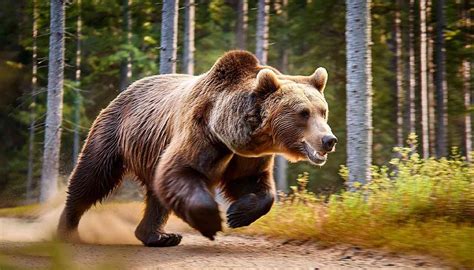
A grizzly bear in Montana demonstrated surprising speed in a video captured by a wildlife enthusiast, showcasing the animal’s impressive agility. The short clip, which has gone viral, highlights the often-underestimated athleticism of these apex predators.
Montana Grizzly’s Sprinting Speed Stuns Onlookers
A recently captured video showcasing a grizzly bear’s remarkable sprinting speed in Montana has captivated wildlife enthusiasts and sparked discussions about the athleticism of these powerful creatures. The footage, shared widely online, reveals the bear covering a significant distance in a matter of seconds, underscoring the potential dangers of encountering these animals in the wild and prompting renewed calls for heightened awareness and safety measures in bear country.
The video, believed to have been taken from a safe distance, shows the grizzly bear moving at an unexpectedly rapid pace across an open field. While the exact speed of the bear remains unconfirmed without professional analysis of the footage, its swift movement is visibly impressive, leaving viewers in awe of its power and agility. The clip serves as a stark reminder of the grizzly bear’s predatory capabilities and the importance of maintaining a respectful distance from these animals.
The incident has reignited conversations surrounding bear safety and awareness, particularly for those living in or visiting grizzly bear habitats. Experts emphasize the need for individuals to carry bear spray, make noise while hiking to avoid surprising bears, and properly store food to prevent attracting them to populated areas. The video’s virality underscores the ongoing fascination with these magnificent creatures while simultaneously reinforcing the need for caution and preparedness in bear country.
While the video itself is brief, its impact has been substantial, serving as a vivid illustration of the grizzly bear’s physical prowess. It also highlights the critical role of responsible wildlife observation and the importance of respecting the boundaries between humans and wild animals. The incident serves as a valuable educational tool, promoting greater understanding and awareness of grizzly bear behavior and the measures necessary to ensure the safety of both humans and bears in shared environments.
The Montana Fish, Wildlife & Parks Department has consistently provided resources and guidelines for safe coexistence with grizzly bears. These resources include information on bear behavior, preventative measures, and proper response strategies in the event of an encounter. The department encourages residents and visitors alike to familiarize themselves with these guidelines to minimize the risk of negative interactions with these powerful animals.
Grizzly Bear Speed and Agility: A Closer Look
Grizzly bears are not only known for their size and strength but also for their surprising speed and agility. Despite their bulky appearance, these bears are capable of reaching speeds of up to 35 miles per hour in short bursts. This speed, combined with their powerful claws and teeth, makes them formidable predators and emphasizes the importance of maintaining a safe distance.
The ability of grizzly bears to move quickly is essential for their survival. They use their speed to chase prey, defend themselves and their cubs, and navigate challenging terrain. Their agility also allows them to climb trees, cross rivers, and traverse steep slopes. This combination of strength, speed, and agility makes them well-adapted to the diverse and often harsh environments they inhabit.
The recent video of the Montana grizzly bear further underscores these remarkable physical capabilities. The bear’s swift movement across the open field highlights its ability to accelerate quickly and maintain a high speed for a considerable distance. While the video does not provide precise measurements of the bear’s speed, it offers a compelling visual representation of its athletic prowess.
Bear Safety and Awareness: Essential Guidelines
Living in or visiting grizzly bear country requires a heightened sense of awareness and adherence to established safety guidelines. The Montana Fish, Wildlife & Parks Department, along with other wildlife agencies, provides comprehensive resources to help individuals minimize the risk of bear encounters and ensure their safety.
One of the most crucial safety measures is carrying bear spray. Bear spray is a non-lethal deterrent that can effectively stop a bear attack if used correctly. It works by temporarily incapacitating the bear, giving the person time to escape. Experts recommend carrying bear spray at all times when in bear country and knowing how to use it properly.
Another essential safety precaution is making noise while hiking. Bears typically avoid human contact, and making noise alerts them to your presence, reducing the likelihood of a surprise encounter. Hiking in groups is also recommended, as groups are generally louder and more visible than individuals.
Proper food storage is also critical to prevent attracting bears to populated areas. Bears have a keen sense of smell and are attracted to human food, garbage, and other attractants. Storing food in bear-resistant containers or hanging it from trees can help prevent bears from accessing these attractants and becoming habituated to human presence.
In the event of a bear encounter, it is important to remain calm and assess the situation. If the bear is unaware of your presence, slowly back away and avoid making sudden movements. If the bear is aware of your presence, speak in a calm voice and avoid direct eye contact. If the bear charges, stand your ground and prepare to use bear spray.
The Significance of the Video: Education and Conservation
The viral video of the Montana grizzly bear serves as a valuable educational tool, raising awareness about the behavior and capabilities of these magnificent animals. By showcasing the bear’s speed and agility, the video helps dispel misconceptions and promotes a greater understanding of their natural behavior.
The video also highlights the importance of conservation efforts aimed at protecting grizzly bear populations and their habitats. Grizzly bears are a keystone species, playing a vital role in maintaining the health and balance of their ecosystems. Protecting their habitats and ensuring their long-term survival is essential for preserving biodiversity and ecological integrity.
The ongoing conservation efforts include habitat management, population monitoring, and public education programs. These efforts are aimed at minimizing human-wildlife conflict, promoting responsible land use practices, and fostering a greater appreciation for the importance of grizzly bears and their role in the natural world.
The Importance of Responsible Wildlife Observation
The video of the Montana grizzly bear also underscores the importance of responsible wildlife observation. While it is natural to be curious and fascinated by these animals, it is crucial to maintain a safe distance and avoid disturbing their natural behavior. Approaching bears too closely can stress them, increase the risk of aggression, and potentially lead to dangerous encounters.
Responsible wildlife observation includes using binoculars or telephoto lenses to view animals from a distance, avoiding feeding or approaching them, and respecting their space. It also involves following established guidelines and regulations, such as staying on designated trails and avoiding sensitive areas during critical periods, such as mating season or denning season.
By practicing responsible wildlife observation, individuals can minimize their impact on wildlife and ensure that these animals can continue to thrive in their natural habitats. It also allows for a more rewarding and enriching experience, as observing animals in their natural environment without disturbing them provides a unique and valuable perspective on their behavior and ecology.
Grizzly Bear Habitats and Distribution
Grizzly bears are found in a variety of habitats, including forests, mountains, and grasslands. In North America, they primarily inhabit the western regions of the United States and Canada, as well as parts of Alaska. Their distribution has been significantly reduced compared to their historical range, due to habitat loss, hunting, and other human-related factors.
In Montana, grizzly bears are found primarily in the western part of the state, including the Greater Yellowstone Ecosystem and the Northern Continental Divide Ecosystem. These areas provide essential habitat for grizzly bears, including abundant food sources, denning sites, and secure travel corridors.
The ongoing conservation efforts in Montana and other states are aimed at expanding grizzly bear populations and restoring them to their historical range. These efforts include habitat restoration, conflict reduction measures, and public education programs.
Human-Wildlife Conflict: Mitigation Strategies
Human-wildlife conflict is a significant challenge in areas where humans and grizzly bears share the same landscape. As human populations grow and development expands, the potential for interactions between humans and bears increases, leading to conflicts over food, space, and other resources.
Mitigation strategies are essential to minimize human-wildlife conflict and ensure the safety of both humans and bears. These strategies include:
- Bear-resistant waste management: Implementing bear-resistant garbage cans and dumpsters in residential areas and campgrounds can prevent bears from accessing human food sources.
- Electric fencing: Installing electric fences around livestock pastures, gardens, and other vulnerable areas can deter bears from entering and causing damage.
- Public education: Providing educational materials and outreach programs to inform residents and visitors about bear behavior, safety precautions, and responsible wildlife viewing practices.
- Relocation: In some cases, bears that are repeatedly involved in conflicts with humans may be relocated to remote areas to reduce the risk of future incidents.
The Future of Grizzly Bear Conservation
The future of grizzly bear conservation depends on continued efforts to protect their habitats, reduce human-wildlife conflict, and promote public awareness. Ongoing research and monitoring are essential to track population trends, assess the effectiveness of conservation strategies, and adapt management practices as needed.
Collaboration among government agencies, conservation organizations, and local communities is crucial to ensure the long-term survival of grizzly bears. By working together, these stakeholders can develop and implement effective conservation strategies that benefit both humans and bears.
The viral video of the Montana grizzly bear serves as a reminder of the importance of these conservation efforts and the need to continue working towards a future where humans and grizzly bears can coexist peacefully.
In-Depth Analysis: The Science Behind Grizzly Bear Speed
The sprinting speed of a grizzly bear, as vividly illustrated in the recent Montana video, is a testament to its complex physiology and evolutionary adaptations. While the video provides a visual representation, a deeper understanding requires examining the biological factors that contribute to this impressive athleticism.
Musculoskeletal Adaptations:
Grizzly bears possess a robust musculoskeletal system optimized for both power and bursts of speed. Their large muscle mass, particularly in the hindquarters, generates the force necessary for rapid acceleration. These muscles are composed of a mix of fast-twitch and slow-twitch fibers. Fast-twitch fibers enable short bursts of high-intensity activity, while slow-twitch fibers provide endurance for sustained movement. The proportion of these fiber types can vary between individual bears and may be influenced by factors such as age, sex, and habitat.
The skeletal structure of the grizzly bear also plays a crucial role in its speed. Their relatively short, powerful legs provide leverage for explosive movements. The shoulder blades are loosely attached, allowing for a wider range of motion and a longer stride length. The paws, equipped with long, non-retractile claws, provide traction on various surfaces, enabling the bear to maintain its grip while running.
Cardiovascular and Respiratory Systems:
Sustaining high speeds requires an efficient cardiovascular and respiratory system to deliver oxygen to the working muscles and remove waste products. Grizzly bears have a large heart relative to their body size, allowing for a high cardiac output. Their blood is also rich in hemoglobin, the protein that carries oxygen. The lungs are highly efficient at extracting oxygen from the air, and the respiratory rate increases significantly during periods of intense activity.
Metabolic Processes:
The metabolic processes within the grizzly bear’s body are finely tuned to support its energetic demands. During sprinting, the bear relies primarily on anaerobic metabolism, which does not require oxygen but produces lactic acid as a byproduct. The accumulation of lactic acid can lead to muscle fatigue, limiting the duration of high-speed activity. However, grizzly bears have adaptations that help them tolerate higher levels of lactic acid, allowing them to maintain their speed for longer periods.
Neurological Control:
The nervous system plays a critical role in coordinating the complex movements required for sprinting. The brain sends signals to the muscles, controlling the timing and force of contractions. The cerebellum, a region of the brain responsible for motor control, is particularly well-developed in grizzly bears, enabling them to execute precise and coordinated movements.
Factors Influencing Speed:
Several factors can influence the sprinting speed of a grizzly bear, including:
- Age: Younger bears may be less experienced and less coordinated than adults, while older bears may have reduced muscle mass and flexibility.
- Sex: Male grizzly bears are typically larger and more muscular than females, which may give them a slight advantage in terms of speed.
- Habitat: Bears living in open habitats may have more opportunities to develop their sprinting skills compared to those living in dense forests.
- Motivation: The motivation of the bear can also influence its speed. A bear chasing prey or defending its cubs may be more likely to run at its maximum speed compared to a bear simply exploring its surroundings.
Comparative Analysis: Grizzly Bear Speed vs. Other Animals
While the video of the Montana grizzly bear showcases its impressive speed, it is important to put it in perspective by comparing it to other animals. As mentioned, grizzly bears can reach speeds of up to 35 miles per hour in short bursts. This is comparable to the speed of a domestic dog or a horse. However, some animals are significantly faster.
- Cheetah: The cheetah is the fastest land animal, capable of reaching speeds of up to 75 miles per hour. However, cheetahs can only maintain this speed for short distances.
- Pronghorn: The pronghorn is the second-fastest land animal, capable of reaching speeds of up to 60 miles per hour. Pronghorns are also highly endurance runners.
- Lion: Lions can reach speeds of up to 50 miles per hour in short bursts.
While grizzly bears may not be the fastest animals on earth, their speed is still remarkable considering their size and build. Their combination of strength, speed, and agility makes them formidable predators and emphasizes the importance of respecting their capabilities.
Ethical Considerations and Responsible Reporting
The viral video of the Montana grizzly bear raises ethical considerations about wildlife photography and the potential impact of human presence on animal behavior. While the video provides a valuable glimpse into the bear’s athleticism, it is important to consider the circumstances under which it was filmed and whether the photographer may have inadvertently disturbed the animal.
Responsible wildlife photography involves maintaining a safe distance from animals, avoiding any actions that could stress or endanger them, and respecting their natural behavior. It also involves obtaining any necessary permits or permissions and adhering to ethical guidelines established by professional organizations.
In the context of reporting on wildlife-related news, it is important to avoid sensationalizing or exaggerating the potential risks or threats posed by wild animals. Instead, the focus should be on providing accurate and informative coverage that promotes understanding and appreciation for wildlife and encourages responsible behavior.
Frequently Asked Questions (FAQ):
1. How fast can a grizzly bear actually run?
Grizzly bears can reach speeds of up to 35 miles per hour in short bursts. While the video of the Montana grizzly bear doesn’t provide an exact measurement, it clearly demonstrates their ability to move surprisingly fast.
2. What should I do if I encounter a grizzly bear in the wild?
If you encounter a grizzly bear, remain calm. If the bear is unaware of your presence, slowly back away. If the bear is aware, speak in a calm voice and avoid direct eye contact. Have bear spray readily available and know how to use it. Never run from a grizzly bear.
3. Is it safe to hike in grizzly bear country?
Hiking in grizzly bear country can be safe if you take the necessary precautions. Carry bear spray, make noise while hiking, hike in groups, and store food properly. Be aware of your surroundings and avoid areas with recent bear activity.
4. What attracts grizzly bears to human areas?
Grizzly bears are attracted to human areas by food, garbage, and other attractants. Storing food in bear-resistant containers and properly managing waste can help prevent bears from entering populated areas.
5. What conservation efforts are in place to protect grizzly bears?
Conservation efforts include habitat management, population monitoring, conflict reduction measures, and public education programs. These efforts aim to expand grizzly bear populations, restore their historical range, and minimize human-wildlife conflict.









